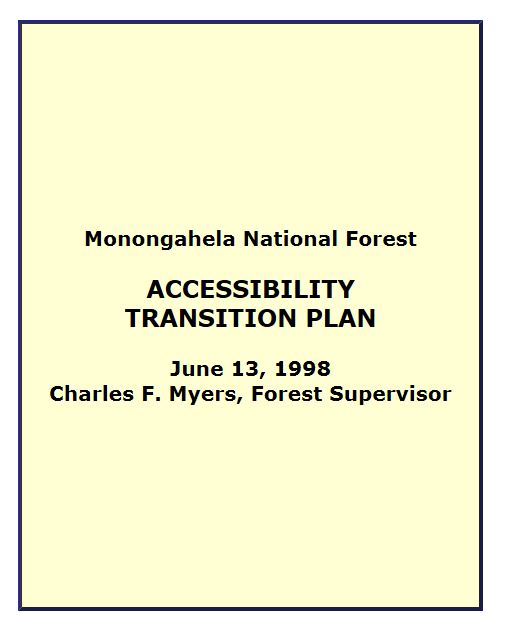USDA Forest Service Missoula Technology and Development Center Facilities Toolbox: Accessibility Tools
What is a transition plan? Does every facility need one?
A transition plan guides work needed to bring facilities and programs that are not accessible into compliance with accessibility standards. Every transition plan includes:
1. A list of obstacles to accessibility of the facility or program. An accessibility evaluation survey is conducted to determine the accessibility obstacles and issues.
2. A detailed description of the methods that will be used to provide accessibility.
3. A schedule for implementing the changes. If completion will take longer than a year, the steps that will be taken each year must be identified.
4. Signoff by the responsible Forest Service official. This official must have the authority to authorize the expenditure of funds to make the changes.

No standardized format was provided in 1991, when the Forest Service provided funding to each region to complete the transition plans. Each region, and in some cases each national forest, developed its own transition plan format.
Regional transition plan formats are available from the Regional Recreation Accessibility Coordinators or Regional Facilities Program Leaders (Web site available only to FS and BLM employees). If your region does not have a standard format, use the format for your forest. If your forest does not have a standard format, ask the region’s facilities program leader or recreation accessibility coordinator to recommend a format that has been used successfully by another forest or region.
Transition plans must be available to the public.
Does every existing facility need a transition plan? Yes, unless the facility is already accessible. 7 CFR 15e Section 150 Program Accessibility: Existing Facilities requires transition plans to be developed for every facility that does not currently provide program accessibility. Although some regions have approached transition plans by starting with 20 percent of the region’s facilities, the law requires transition plans for all facilities that are not accessible. The law does allow a program to be "viewed in its entirety" when evaluating its accessibility. However, if a program is not accessible because the facility is not accessible, the forest must develop and implement a transition plan for that program and facility.
Since the 1968 passage of the Architectural Barriers Act (ABA), newly acquired, constructed, or altered buildings that are owned, rented, or leased by or for a Federal agency have been required to be accessible. A lot of Forest Service facilities were built before 1968. Some of the facilities built since then were not designed or constructed in compliance with the requirements of the Uniform Federal Accessibility Standards.
In the early 1990s, the Forest Service began an aggressive attempt to correct accessibility deficiencies, calling for all units to complete a transition plan identifying the changes needed to make each facility accessible. Funding to complete the transition plans was provided to the regions in 1991, 1992, and 1993.
7 CFR 15e, the accessibility regulation governing all USDA agencies became law in December 1994. It includes a requirement for completing transition plans for all facilities that were not accessible by 12/31/1997. The specifics of developing a transition plan are cited in 7 CFR 15e Section 150(d). All units were informed of the timeline requirement.
In 1998, under Public Law 105-359, Congress mandated an evaluation of the accessibility of outdoor recreation on federally managed lands for both USDA and U.S. Department of the Interior agencies. The results of that independent study, published in June of 2000, highlighted to Congress that many Forest Service units had not completed their transition plans. The Forest Service is now under increased pressure to ensure that those plans are completed. That is why the national budget direction each year since Fiscal Year 2001 has included direction to the field to complete the transition plans.

User Comments/Questions
Add Comment/Question